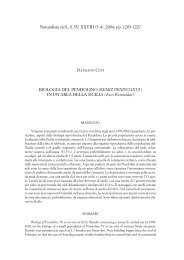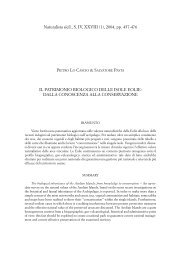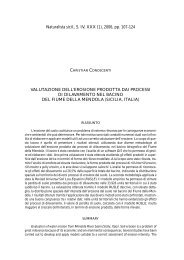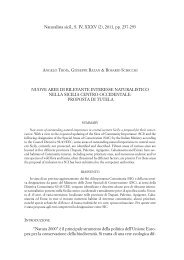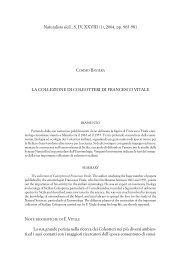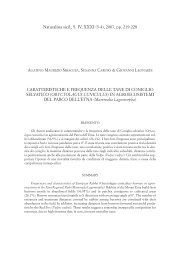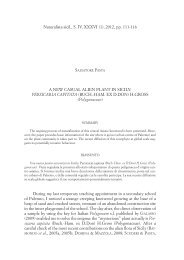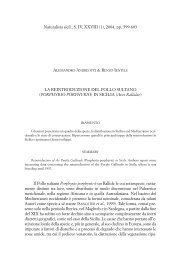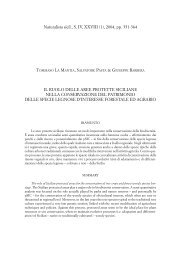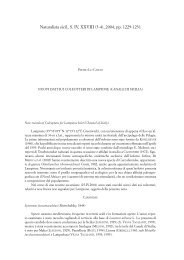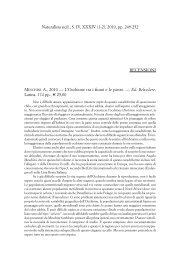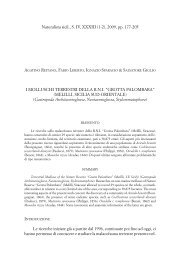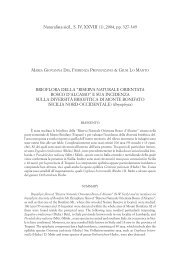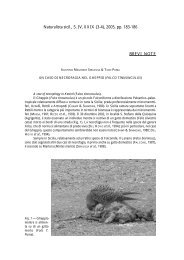2007,pp - Società Siciliana di Scienze Naturali
2007,pp - Società Siciliana di Scienze Naturali
2007,pp - Società Siciliana di Scienze Naturali
You also want an ePaper? Increase the reach of your titles
YUMPU automatically turns print PDFs into web optimized ePapers that Google loves.
Gall midges (Diptera Cecidomyiidae) of Sicily<br />
281<br />
1827). VACANTE & FIRULLO (1983), VACANTE (1985) and COLOMBO et al.<br />
(1993) propose to use larvae of F. acarisuga for biological control of red spider<br />
mites in Sicilian greenhouses. Occurrence: COLOMBO et al. (1993) made<br />
their trials in Ragusa, LONGO et al. (2001) report occurrence of this species<br />
from the Etna region. Distribution: widespread in Europe and occurring in<br />
other parts of the world.<br />
Geocrypta galii (H. Loew, 1850)<br />
Larvae cause swellings on stems of various species of Galium L. (Rubiaceae)<br />
(Pl. V, Fig. 27). Two generations develop per year. Fully grown larvae<br />
leave galls, fall to the ground and pupate in the soil. Occurrence: DE STEFANI<br />
(1901, 1902, 1905a, 1906c) found in May galls of this species in Palermo and<br />
its surroun<strong>di</strong>ngs (Mt. Pellegrino) on Galium pallidum Presl., G. cinereum All.<br />
and G. saccaratum L.; he also recorded it (as Cecidomyine) on G. saccaratum<br />
on Pantelleria Is. in March and April. Distribution: Euro-Siberian, occurring<br />
up to Kazakhstan.<br />
Gephyraulus <strong>di</strong>plotaxis (Solinas, 1982)<br />
Larvae cause flower bud galls on Diplotaxis muralis D.C. (Brassicaceae).<br />
SOLINAS (1982) described this species from material collected in Bari. Flower<br />
bud galls on Diplotaxis crassifolia L. were found in Enna (formerly Castrogiovanni),<br />
1000 m a.s.l., in May 1893 by H. Ross (MASSALONGO & ROSS,<br />
1898) and the causer was identified as “Cecidomyidarum spec.”. Comparison<br />
of the spatula sternalis of the larva figured in MASSALONGO & ROSS (1898)<br />
with figures published by SOLINAS (1982) consents to establish that they are<br />
the same species. Probably also fin<strong>di</strong>ng of DE STEFANI jr (1942), described as<br />
a hypertrophy on the flowers of Diplotaxis harra Boiss. [= D. crassifolia<br />
(Rafin.)] and D. crassifolia from Enna, it is caused by this species. Distribution:<br />
Me<strong>di</strong>terranean.<br />
Hartigiola annulipes (Hartig, 1839)<br />
Larvae produce cylindrical usually densely haired galls on leaves of<br />
Fagus sylvatica L. (Fagaceae) (Pl. I, Fig. 6). Each gall contains one single larva.<br />
Only one generation develops in a year. Larvae remain in galls that separate<br />
from leaves in the autumn. Larvae hibernate in galls fallen on the ground and<br />
pupate there in spring. Occurrence: DE STEFANI (1912) found galls at Bosco<br />
Dragonara on Madonie Mts. (1400 m) and identified them as “Oligotrophus<br />
sp.” Recently galls are quite common on Madonie, Nebro<strong>di</strong> and Etna Mts. up<br />
to 1800 m. Distribution: European, found also in Turkey (SKUHRAVÁ et al.,<br />
2005).



